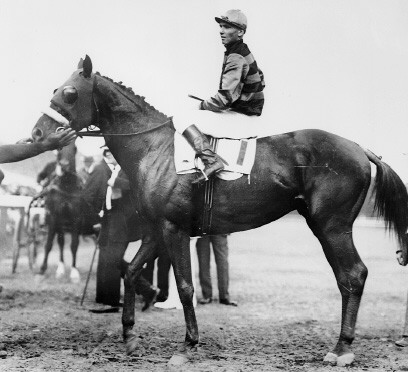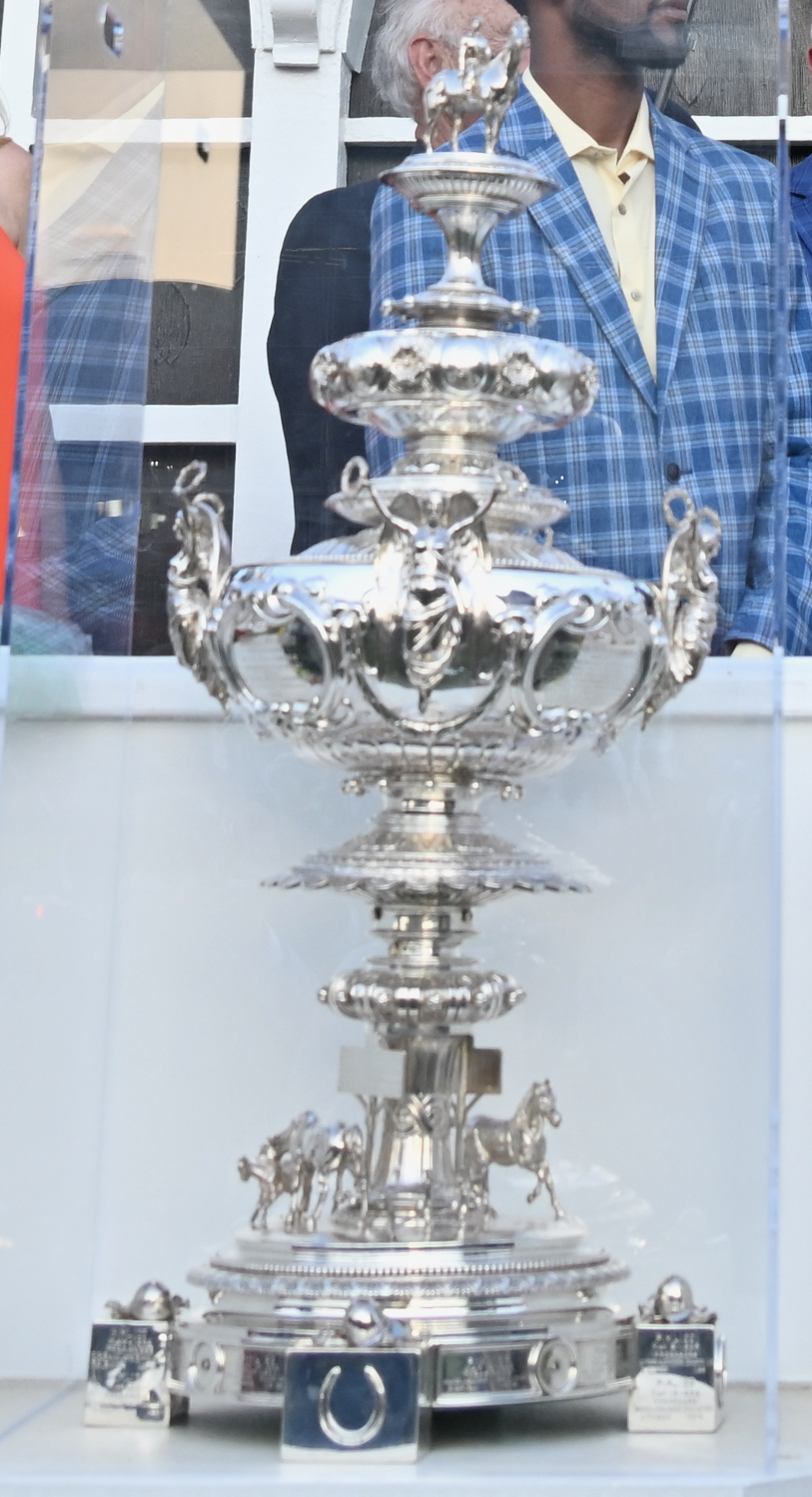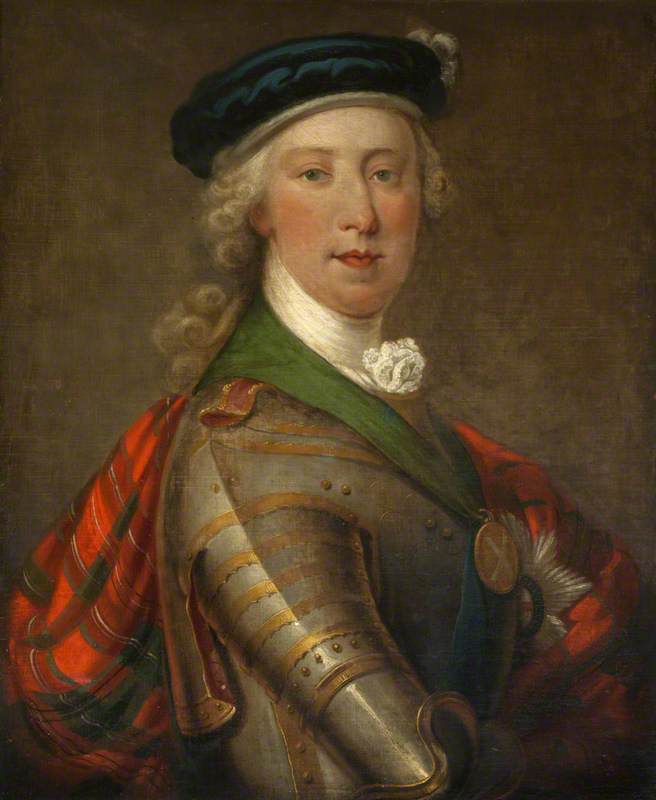|
Kalitan
Kalitan (1914 – 1935) was an American Thoroughbred racehorse best known for winning the 1917 Preakness Stakes. Owned by Edward R. Bradley, he was sired by Rey Hindoo. Kalitan was out of the mare Dally, a daughter of Giganteum. Preakness Stakes Kalitan is probably best remembered for his win in the $7,500 Preakness Stakes at Pimlico Race Course in Baltimore, Maryland in which he finished in a final time of 1:54.40 for the one and one eighth mile race. On May 12, 1917, Kalitan's owner, Edward R. Bradley, entered the horse in the 42nd running of the Preakness Stakes in a capacity field of 14 stakes winning colts. That race drew a full field even though it was held on the same day as the Kentucky Derby that was won by Omar Khayyam. The Preakness and Kentucky Derby were held on the same day again on May 13, 1922. Breaking from post position five, Kalitan started at odds of 10-1 under jockey Everett Haynes and settled in third behind leader Fruit Cake and Jock Scot passing th ... [...More Info...] [...Related Items...] OR: [Wikipedia] [Google] [Baidu] |
Preakness Stakes
The Preakness Stakes is an American thoroughbred horse race held on Armed Forces Day which is also the third Saturday in May each year at Pimlico Race Course in Baltimore, Maryland. It is a Grade I race run over a distance of 9.5 furlongs () on dirt. Colts and geldings carry ; fillies . It is the second jewel of the Triple Crown, held two weeks after the Kentucky Derby and three weeks before the Belmont Stakes. First run in 1873, the Preakness Stakes was named by a former Maryland governor after the colt who won the first Dinner Party Stakes at Pimlico. The race has been termed "The Run for the Black-Eyed Susans" because a blanket of Maryland's state flower is placed across the withers of the winning colt or filly. Attendance at the Preakness Stakes ranks second in North America among equestrian events, surpassed only by the Kentucky Derby. History Two years before the Kentucky Derby was run for the first time, Pimlico introduced its new stakes race for three-year-olds, the ... [...More Info...] [...Related Items...] OR: [Wikipedia] [Google] [Baidu] |
Woodlawn Vase
The Woodlawn Vase is an American trophy given annually to the winning owner of the Preakness Stakes at Pimlico Race Course in Baltimore, Maryland. Overview of the trophy After the Preakness Stakes is run each year on the third Saturday of May, the winners are awarded the Woodlawn Vase on national television. The vase was first awarded in 1861 to a stakes-winning mare named Mollie Jackson in Louisville, Kentucky. In 1917, the Woodlawn Vase became the official trophy for the winner of the second jewel of the Triple Crown and was awarded to the Preakness winner Kalitan. For many years the trophy was given to the winning owner to keep for one year until the next running of the race. In 1953, Native Dancer won the Preakness Stakes and the wife of winning owner Alfred Gwynne Vanderbilt Jr. (Jeanne Murray Vanderbilt) declined to take annual possession of the trophy because of its monetary and sentimental value to the sport. Following 1953, the winning owner of the horse that won The P ... [...More Info...] [...Related Items...] OR: [Wikipedia] [Google] [Baidu] |
Stallion (horse)
A stallion is a male horse that has not been gelded (castrated). Stallions follow the conformation and phenotype of their breed, but within that standard, the presence of hormones such as testosterone may give stallions a thicker, "cresty" neck, as well as a somewhat more muscular physique as compared to female horses, known as ''mares'', and castrated males, called ''geldings''. Temperament varies widely based on genetics, and training, but because of their instincts as herd animals, they may be prone to aggressive behavior, particularly toward other stallions, and thus require careful management by knowledgeable handlers. However, with proper training and management, stallions are effective equine athletes at the highest levels of many disciplines, including horse racing, horse shows, and international Olympic competition. "Stallion" is also used to refer to males of other equids, including zebras and donkeys. Herd behavior Contrary to popular myths, many stallions do not ... [...More Info...] [...Related Items...] OR: [Wikipedia] [Google] [Baidu] |
Prince Charlie (horse)
Charles Edward Louis John Sylvester Maria Casimir Stuart (20 December 1720 – 30 January 1788) was the elder son of James Francis Edward Stuart, grandson of James II and VII, and the Stuart claimant to the thrones of England, Scotland and Ireland from 1766 as Charles III. During his lifetime, he was also known as "the Young Pretender" and "the Young Chevalier"; in popular memory, he is known as Bonnie Prince Charlie. Born in Rome to the exiled Stuart court, he spent much of his early and later life in Italy. In 1744, he travelled to France to take part in a planned Planned French invasion of Britain (1744), invasion to restore the Stuart monarchy under his father. When the French fleet was partly wrecked by storms, Charles resolved to proceed to Scotland following discussion with leading Jacobites. This resulted in Charles landing by ship on the west coast of Scotland, leading to the Jacobite rising of 1745. The Jacobite forces under Charles initially achieved several victo ... [...More Info...] [...Related Items...] OR: [Wikipedia] [Google] [Baidu] |
Preakness Stakes Winners
Preakness may refer to: * The Preakness or Preakness Stakes, an American flat thoroughbred horse race held in Baltimore, Maryland * Preakness (horse), an American thoroughbred racehorse from Preakness Stables * Preakness, New Jersey, a section of Wayne in Passaic County, New Jersey * Preakness Range, a range of the Watchung Mountains in northern New Jersey * Preakness Stud Preakness Stud was the Thoroughbred horse racing and breeding operation established by Medway, Massachusetts businessman Milton H. Sanford in the Preakness section of Wayne, New Jersey at what today is the corner of Valley Road and Preakness Av ..., a former thoroughbred horse racing breeding farm and racing stable in Preakness, New Jersey See also * {{disambiguation, geo ... [...More Info...] [...Related Items...] OR: [Wikipedia] [Google] [Baidu] |
Racehorses Trained In The United States
Horse racing is an equestrian performance sport, typically involving two or more horses ridden by jockeys (or sometimes driven without riders) over a set distance for competition. It is one of the most ancient of all sports, as its basic premise – to identify which of two or more horses is the fastest over a set course or distance – has been mostly unchanged since at least classical antiquity. Horse races vary widely in format, and many countries have developed their own particular traditions around the sport. Variations include restricting races to particular breeds, running over obstacles, running over different distances, running on different track surfaces, and running in different gaits. In some races, horses are assigned different weights to carry to reflect differences in ability, a process known as handicapping. While horses are sometimes raced purely for sport, a major part of horse racing's interest and economic importance is in the gambling associated with i ... [...More Info...] [...Related Items...] OR: [Wikipedia] [Google] [Baidu] |
Racehorses Bred In Kentucky
Horse racing is an equestrian performance sport, typically involving two or more horses ridden by jockeys (or sometimes driven without riders) over a set distance for competition. It is one of the most ancient of all sports, as its basic premise – to identify which of two or more horses is the fastest over a set course or distance – has been mostly unchanged since at least classical antiquity. Horse races vary widely in format, and many countries have developed their own particular traditions around the sport. Variations include restricting races to particular breeds, running over obstacles, running over different distances, running on different track surfaces, and running in different gaits. In some races, horses are assigned different weights to carry to reflect differences in ability, a process known as handicapping. While horses are sometimes raced purely for sport, a major part of horse racing's interest and economic importance is in the gambling associated with i ... [...More Info...] [...Related Items...] OR: [Wikipedia] [Google] [Baidu] |
1935 Racehorse Deaths
Events January * January 7 – Italian premier Benito Mussolini and French Foreign Minister Pierre Laval conclude an agreement, in which each power agrees not to oppose the other's colonial claims. * January 12 – Amelia Earhart becomes the first person to successfully complete a solo flight from Hawaii to California, a distance of 2,408 miles. * January 13 – A plebiscite in the Territory of the Saar Basin shows that 90.3% of those voting wish to join Germany. * January 24 – The first canned beer is sold in Richmond, Virginia, United States, by Gottfried Krueger Brewing Company. February * February 6 – Parker Brothers begins selling the board game Monopoly in the United States. * February 13 – Richard Hauptmann is convicted and sentenced to death for the kidnapping and murder of Charles Lindbergh Jr. in the United States. * February 15 – The discovery and clinical development of Prontosil, the first broadly effective antibiotic, is published in a series ... [...More Info...] [...Related Items...] OR: [Wikipedia] [Google] [Baidu] |
1914 Racehorse Births
This year saw the beginning of what became known as World War I, after Archduke Franz Ferdinand of Austria, heir to the Austrian throne was Assassination of Archduke Franz Ferdinand, assassinated by Serbian nationalist Gavrilo Princip. It also saw the first airline to provide scheduled regular commercial passenger services with heavier-than-air aircraft, with the St. Petersburg–Tampa Airboat Line. Events January * January 1 – The St. Petersburg–Tampa Airboat Line in the United States starts services between St. Petersburg, Florida, St. Petersburg and Tampa, Florida, becoming the first airline to provide scheduled regular commercial passenger services with heavier-than-air aircraft, with Tony Jannus (the first federally-licensed pilot) conveying passengers in a Benoist XIV flying boat. Abram C. Pheil, mayor of St. Petersburg, is the first airline passenger, and over 3,000 people witness the first departure. * January 11 – The Sakurajima volcano in Japan b ... [...More Info...] [...Related Items...] OR: [Wikipedia] [Google] [Baidu] |
Leamington (horse)
Leamington (1853–1878) was a champion American Thoroughbred racehorse and an influential sire in the United States during the second half of the nineteenth century. Background Leamington was a brown horse bred in England by Mr. Halford. Leamington was by the top racehorse and sire Faugh-a-Ballagh (by Sir Hercules). His dam was an unnamed mare by Pantaloon who was bred by the Marquis of Westminster.Morris, Simon; ''Tesio Power 2000 - Stallions of the World'', Syntax Software Racing career 1855: Two-Year-Old Season Halford began racing him at age two, and then sold him to a Mr. Higgins. Leamington won the Woodcote Stakes at Warwick and the Chesterfield Stakes, before being retired for the year. 1856: Three-Year-Old Season As a three-year-old, it was planned to run the colt in The Derby, but he contracted strangles, and this affected his whole three-year-old season. However, his owners and trainers appeared to have planned his losses to help keep his handicap weight down. Af ... [...More Info...] [...Related Items...] OR: [Wikipedia] [Google] [Baidu] |
Macaroni (horse)
Macaroni (1860–1887) was a British Thoroughbred racehorse and sire. In a career that lasted from October 1862 to September 1863 he ran eight times and won seven races. In 1863 he won all seven of his races including the 2000 Guineas at Newmarket, The Derby and the Doncaster Cup. Background Macaroni was bred by Richard Grosvenor, 2nd Marquess of Westminster at his Eaton stud in Cheshire. In 1861 Macaroni was one of several yearlings at the stud to be affected by an outbreak of an equine respiratory disease known as Strangles, which adversely affected his physical development and persuaded the Marquis to sell him. Macaroni was part of a lot of six yearlings bought for £700 by the Liverpool banker Richard Naylor, who had recently started his own stud at Hooton Park on the Wirral Peninsula. Naylor sent the young horses to be trained by James "Jem" Godding at his Palace House stable at Newmarket, Suffolk. At the time, Newmarket was falling out of favour as a base for ... [...More Info...] [...Related Items...] OR: [Wikipedia] [Google] [Baidu] |
Doncaster (horse)
Doncaster (1870 – January 1892) was an English Thoroughbred racehorse and sire. He was the winner of the 1873 Epsom Derby and the sire of the great stallion Bend Or. Through Bend Or he is the direct male-line ancestor of most modern thoroughbreds. Breeding Doncaster was foaled at the Sledmere Stud, Yorkshire, Great Britain and was sired by "The Emperor of Stallions", Stockwell, who had won both the 2,000 Guineas and the St. Leger Stakes; Stockwell was a leading sire during his later years, producing many classic winners. Doncaster's dam Marigold had a fairly good career on the track, and was sired by The Derby winner Teddington.Ahnert, Rainer L. (editor in chief), “Thoroughbred Breeding of the World”, Pozdun Publishing, Germany, 1970 Doncaster, a chestnut with a white blaze originally named "All Heart and No Peel", was raised at the Sledmere Stud before he was sent to the Tattersalls auction. James Merry bought the colt for 950 guineas, changed his name to Doncaster ... [...More Info...] [...Related Items...] OR: [Wikipedia] [Google] [Baidu] |





.jpg)
